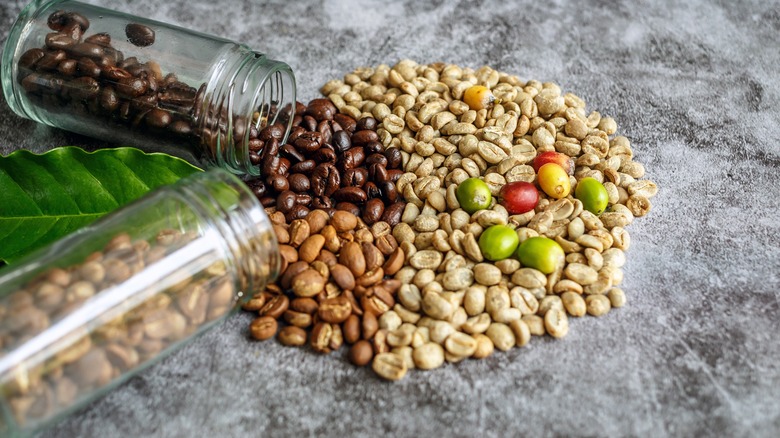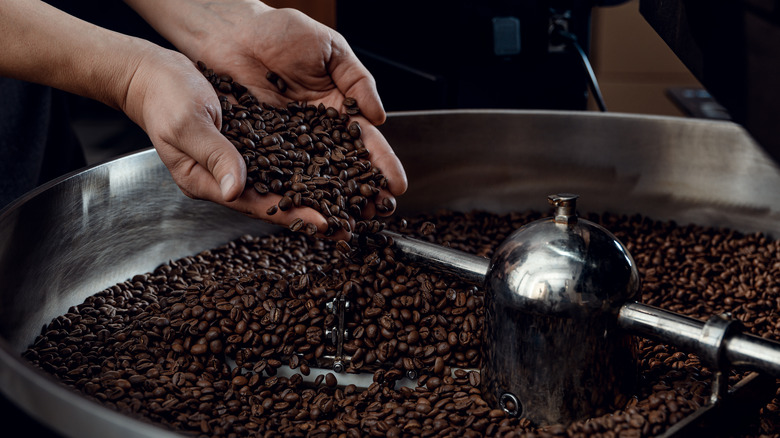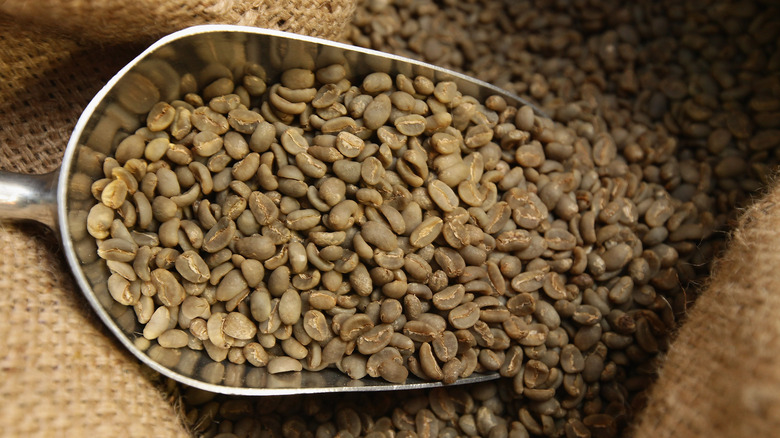How Raw Coffee Beans Compare To Their Roasted Counterpart
Your morning cup of Joe starts off looking very different from the roasted brown beans or powder you use to make it every morning. This is because a raw coffee bean is found nestled inside a bright red berry. Pale green in color and with barely any aroma, a raw bean undergoes a complicated process to separate it from the fruit before it's ready to be roasted. Even at this stage, how the bean is removed from the fruit affects the final taste of the coffee.
Roasting coffee beans is a complex process and results in all kinds of chemical reactions, including the Maillard reaction, the same the delicious browning and caramelization seen in baked dishes. Several volatile compounds responsible for the characteristic aroma and flavor of coffee are formed during this process. Roasting also brings forth the natural oils in the coffee bean, which are responsible for the velvety mouthfeel and rich crema of an espresso.
Interestingly, raw coffee beans can also be brewed into a beverage sometimes known as green coffee. However, this is nothing like the coffee you may be used to, and several coffee bean alternatives actually taste more like the familiar cup of Joe we know than a cup of brewed green coffee.
Turning cherry seeds into coffee beans
You've probably heard of light, medium, and dark roast coffees. These roast levels refer to the amount of time the coffee beans have been roasted and the temperatures they've been subjected to. Roasting generally occurs between 350 and 500 degrees Fahrenheit, with beans spending between 10 and 20 minutes in the roasting drums.
Even before it is roasted, a raw coffee bean can either undergo a dry, or natural, processing or a wet processing to remove the bean from its fruit. Dry processing, in which the coffee bean is left inside the fruit (the coffee cherry) to dry before it is roasted, results in the beans having a fruitier flavor profile. Generally, the more the coffee bean is roasted, the more it loses its initial fruity and earthy notes.
During roasting, the coffee bean turns from pale green to its characteristic brown. Along with the chemical reactions that take place, the bean also loses moisture and expands in size, thereby making it less dense. This is an important transformation since it is easier to extract flavors from beans of lower densities. You might notice that dark roast beans sometimes look larger than light roast beans. This is due to the beans expanding, and eventually cracking, while being subjected to heat during the roasting process. Therefore, a raw coffee bean is much smaller and denser than its roasted counterpart.
Green coffee beans vs. roasted coffee beans
Green coffee is made using raw coffee beans, resulting in a very different beverage. Green coffee retains the bean's original flavors and therefore, has predominantly fruity and earthy notes. The usual bitter, chocolate, and smoky notes are missing. Without the velvety texture that roasted coffee drinks have, the consistency resembles that of herbal tea. Despite growing popularity, the evidence supporting green coffee's health benefits is still murky, much like butter coffee's unverified health claims,
One oft-asked question about green coffee is regarding its caffeine content. While roasting doesn't significantly affect caffeine content, green coffee generally has less caffeine than its roasted counterpart. This is because despite it containing the same amount of caffeine as a roasted bean, it's harder to extract caffeine from a raw coffee bean.
Because the process of brewing raw, unroasted coffee beans is different from regular coffee brewing methods, don't expect a green coffee espresso. Instead, raw coffee beans must be simmered in water for about 15 minutes to extract flavor. Once filtered, the resulting light green liquid is green coffee extract and can be drunk neat or diluted with additional water. Since green coffee beans are much denser, some methods also recommend soaking the beans overnight before brewing.


